Hubei, China
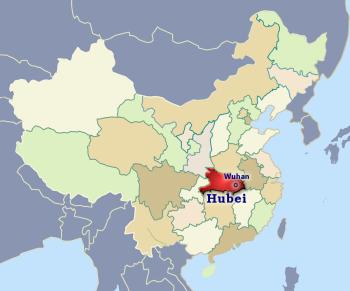
| Province | Hú běi 湖北 'lake north' |
| Short name | 鄂 È |
| Capital | Wuhan |
| Population | 57.753 million (4.09%) [10th] comparison table |
| Area | 186,000 km2 [71,815 mile2] (1.94%) [14th] |
| GDP | 75,223 (17.37%) [11th] |
| Neighbors | Henan Anhui Jiangxi Hunan Chongqing Shaanxi |
| Others | or just click on the map |
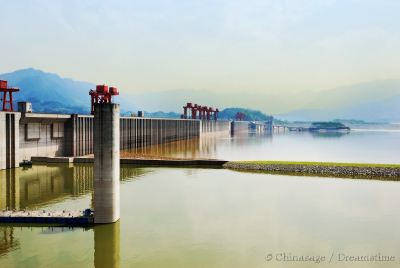
Hubei is a central Chinese province; resembling neighboring Henan as it marks the transition from mountains in the west to low fertile coastal plain in the east. The name Hubei comes from its location north of Dongting Lake. In early days the province was part of the larger 湖广 Hú guǎng province before it was split from Hunan in 1664. Hubei was the heart of the Chu kingdom during the Warring States period of Chinese history. Qu Yuan, the earliest acclaimed Chinese poet lived in Hubei at that time. It is dominated by the Yangzi River (or Chang Jiang) that forms many low lying lakes and reservoirs (the largest number in China) as well as the world famous Three Gorges ➚ (now harnessed by the huge Sanxia Daba dam ➚). Qutang, Wuxia and Xiling are the names of the gorges that are spread out over 120 miles [193 kms] in order west to east (but the first two are in neighboring Chongqing province). Some sites along the river have been drowned by the rise in water level associated with the Three Gorges dam. Wuxia gorge is marked by towering mountains on either side of the river making it seem a chasm. The ancient ‘hanging coffins’ of the Bo people ➚ can still be seen along the river and Su Shi, the great Song poet wrote eloquently about the gorges. The gorges took a heavy toll in people and boats over the centuries; so it is welcome that this big hazard has now been removed.
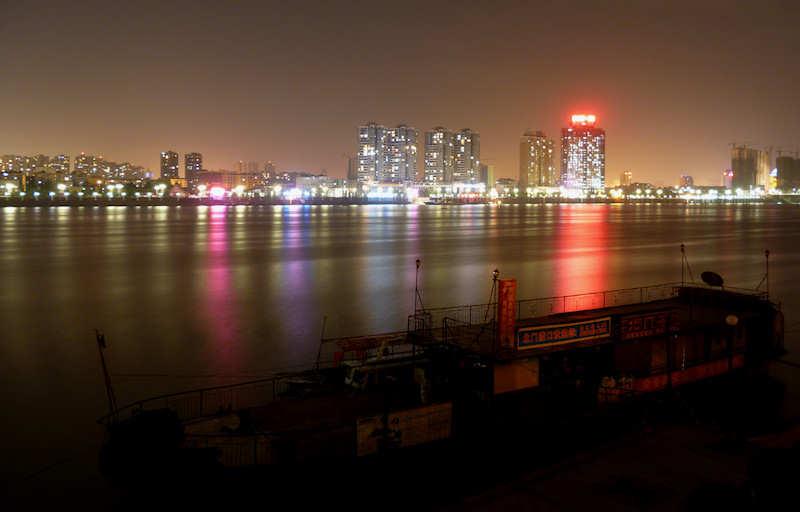
Image by Zihanzor ➚ available under a Creative Commons license ➚
Wuhan
Wuhan is the largest city in Hubei, it was formed in 1926 by combining three neighboring cities Hankou, Wuchang and Hanyang. Wuhan stands at the confluence with another significant Chinese river the ‘Han’ 汉水 hàn shuǐ, and is also on the main railway line from Beijing to Guangzhou . Wuchang was one time capital of the state of Wu in the Zhou dynasty and stands on the southern bank of the river. Hankouafter the first Opium War became a major river port on the Yangzi when trade opened to foreign powers (including the British, French, German, Russian and Japanese). The Yangzi is so broad and deep that large ocean going ships could sail up the river and dock at the city. Some buildings near Hankou city center show this foreign influence. It used to be known as the ‘Street of a thousand shops’.
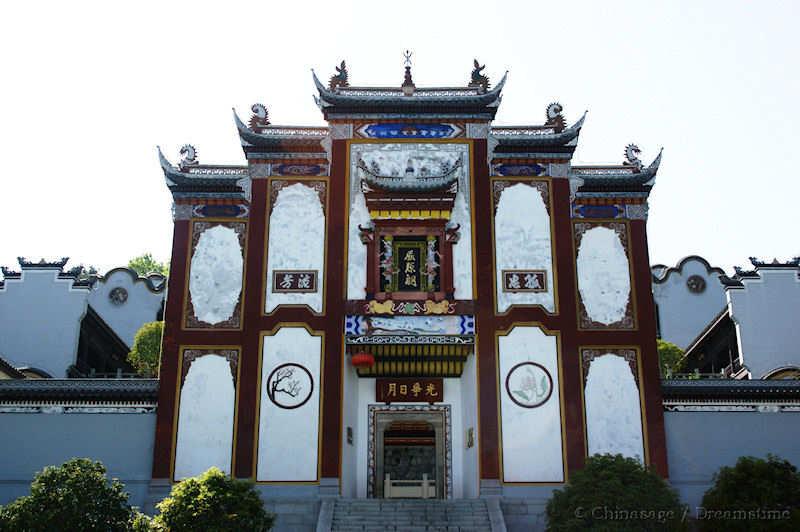

The first case of the deadly Coronavirus (2019-nCoV) was reported in Wuhan on the last day of 2019. It spread quickly within the city and the rest of Hubei province . Strict isolation rules however quickly stopped its rapid spread to the rest of the country.
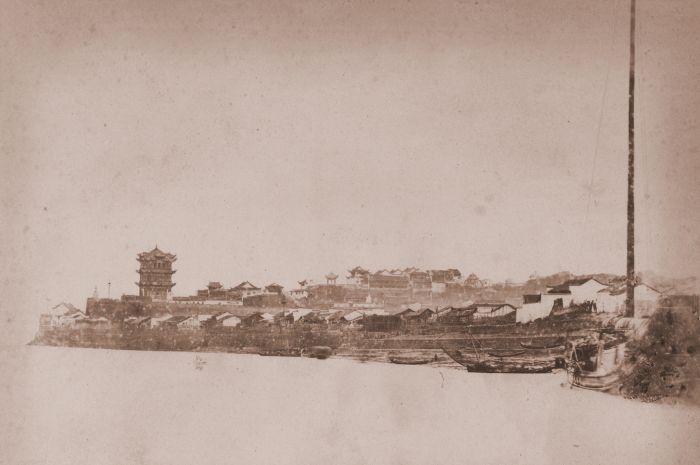
The Wuhan area suffered severe damage in the last century: in 1911 with the fall of the Qing and later in 1923 and then 1937 with the Japanese occupation. The Wuchang Uprising of 1911 led by Sun Yatsen marked the start of the revolution that created the Republic of China. In the late 1930s Wuchang was the de facto capital of unoccupied China. In 1955-57 the Changjiang Daqiao ➚ bridge was the first over the lower Yangzi and opened up the area to rapid development. A second bridge was completed in 1995 and there is now also a tunnel. It was at Wuhan that Mao Zedong made his famous swim of the Yangzi in 1956 and again in 1966. Since this time the city has become heavily industrialized. The provincial museum at Wuhan is one of the best in China with many exhibits from the Warring States and Three Kingdoms periods. Wuhan’s Fengdu Ghost City ➚ is a more unusual tourist attraction.
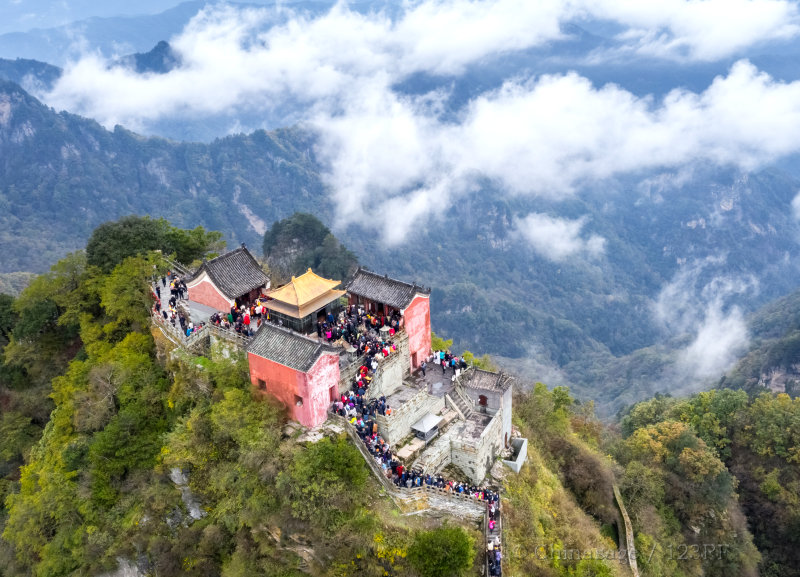
Places to visit in Hubei
Donghu (East Lake) is an attractive park east of the center of Wuhan; it has over 70 pavilions, towers and gardens. On the north east shore is a pavilion dedicated to the memory of the poet Qu Yuan. Near the bridge in Wuchang is the Huanghelou ➚ Yellow Crane Tower standing on the She Shang hill dating back over 1,700 years. A story relates that an immortal came down and drank wine at a shop and painted a yellow crane with orange peel. The lifelike image attracted many visitors until sometime later the immortal returned to fly off on the crane. The present tower has recently been rebuilt several times on the original site, the last time in 1884. The Buddhist Guiyuansi ‘Temple of Original Purity ➚’ has over 54 thousand volumes of ancient sacred texts and hundreds of images of ‘arhats’ - Buddhist saints. The ancient 古琴台 Gǔ qín tái 'Guqin Platform' in Hanyang district commemorates the friendship of the musician Yu Boya and Zhong Zhiqi back in the Warring States period. Ferries run upstream on the Yangzi river via the ancient city of Yichang through the gorges to Chongqing.
Shengnongjia ➚ is a notable National Forest in the mountainous north-west. The reserve has many rare plants, trees and animals (including the Golden Monkey, Golden Pheasant and Giant Salamander). The Wudang ➚ mountains are famous for Daoist temples a few dating back as far as the Tang dynasty scattered among the mountains and gave rise to the Wudangquan ➚/Taijiquan (Taichi) martial art tradition. Parts of the epic film ‘Crouching Tiger, Hidden Dragon ➚’ was filmed here. It is set in a botanically rich area.
In the north-east is the Dabie Shan range of mountains that form part of the geographical division of northern and southern China. These mountains are famous as the birthplace of the founder of the Ming dynasty, Zhu Yuanzhang. It is popular when azaleas are in bloom as the mountains are covered with their bright colored blooms.
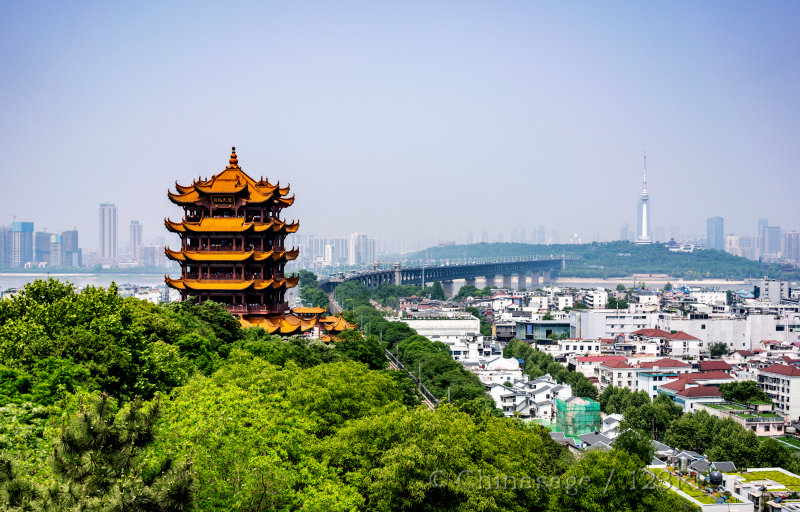
Hubei Geography
Hubei has hot, humid summers and cool, dry winters. Wuhan is one of the ‘three furnaces’ of China in summer with temperatures over 104 ° F [40 ° C] combined with high humidity. Agriculturally it lies on the dividing line of wheat growing in the north to rice growing in the south but it also grows a great many other crops including bamboo, Yichang black tea, Enshi green tea and sesame seeds. Industry is centered on the Wuhan area. The province produces some oil to add to China’s sources of energy.
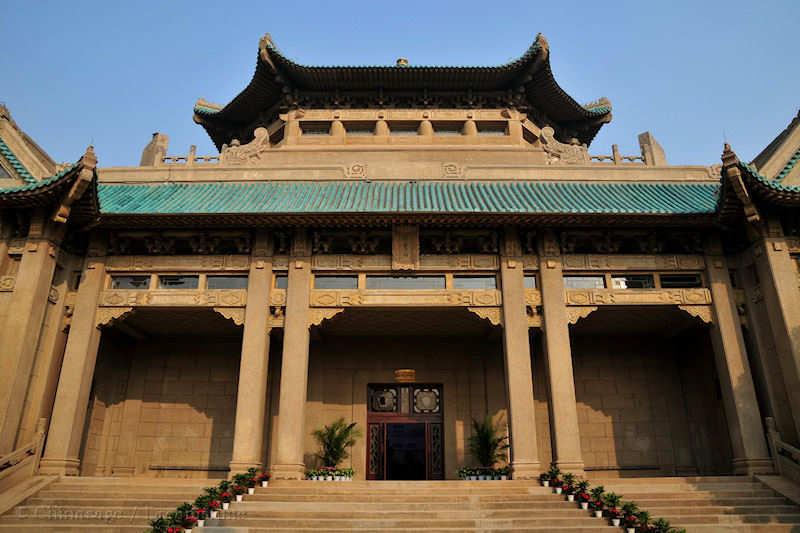
Airports
The airport has 1 terminal and is located 15.5 miles (25.0 kms) from Yichang. Live Flight information ➚, Airport information ➚, rank in China 61
See map of location Yichang Sanxia Airport
The airport has 3 terminals and is located 16.2 miles (26.0 kms) from Wuhan. Live Flight information ➚, Airport information ➚, rank in China 15
International Links to :Korea
See map of location Wuhan Tianhe International Airport
Universities
Wuhan University 武汉大学
The leading university in Hubei province is Wuhan University. It has roots as an institution dating back to 1893 before becoming a University in 1928. It covers most subjects in the arts and sciences.. Undergraduates: 34133, Postgraduates: 13918, International students: 1477, GP World ranking 273Huazhong University of Science and Technology 华中科技大学
Huazhong is the main University in Hubei province and specializes on Science and Technology. In 1953 it began as an engineering institute before merging with other Wuhan institutions in 2000 to become a university.. Undergraduates: 36000, Postgraduates: 20040, International students: 560, GP World ranking 445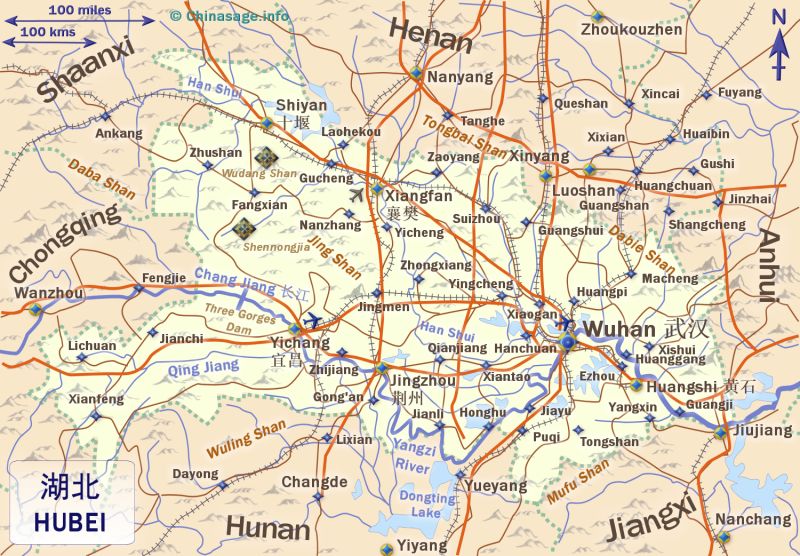
Google map of Hubei
Bing map of Hubei ➚
Show Bing Map ➚
Hubei Climate

| Major Cities | Population | |
|---|---|---|
| Huangshi | 黄石 | 688,090 |
| Jingmen | 荆门 | 167,750 |
| Jingzhou | 荆州 | 177,878 |
| Qianjiang | 潜江 | 179,079 |
| Shashi | 沙市 | 498,780 |
| Shiyan | 十堰 | 3,460,000 |
| Suizhou | 随州 | 323,945 |
| Tianmen | 天门 | 382,362 |
| Wuhan | 武汉 | 12,326,500 |
| Xiangyang | 襄樊 | 1,658,000 |
| Xiantao | 仙桃 | 239,406 |
| Yichang | 宜昌 | 1,698,400 |
Book: 60 Scenic Wonders in China: New World Press: 1980 pp. 148-151, 163-166
Book: A Map History of Modern China: Catchpole: Heinemann: 1976 p. 44
Book: China : Eyewitness Travel: Dorling Kindersley: 2012 pp. 266-273
Book: Insight Guides: China: APA publications: 1994 pp. 307-310
Web page: Book: Larousse Encyclopedia of the World: Hamlyn: 1964 ➚ p. 520
Book: Lonely Planet: China: 1988 pp. 47, 52, 240-248
Book: Modern China: A companion to a rising power: Graham Hutchings:… pp. 211-212
Book: Mowrer in China: Mowrer: Penguin:1938 pp. 49-54
Book: Symbols of China: Feng Jicai: Compendium: 2010 p. 90
Book: The Story of China: Michael Wood: Simon and Schuster: 2020 p. 261
Book: The Water Kingdom: Philip Ball: Vintage: 2017 p. 40
Web page: Hubei (chinafolio) ➚
Web page: Hubei (newworldencyclopedia) ➚
Web page: Hubei (wikitravel) ➚
Web page: Hubei Guide - Renowned For Yangtze River Section In The Province ➚
Magazine: Issue 25 China Eye, Society for Anglo-Chinese Understanding, 2004- pp. 14-17
City populations for 2012, Province statistics National Bureau of Statistics 2014